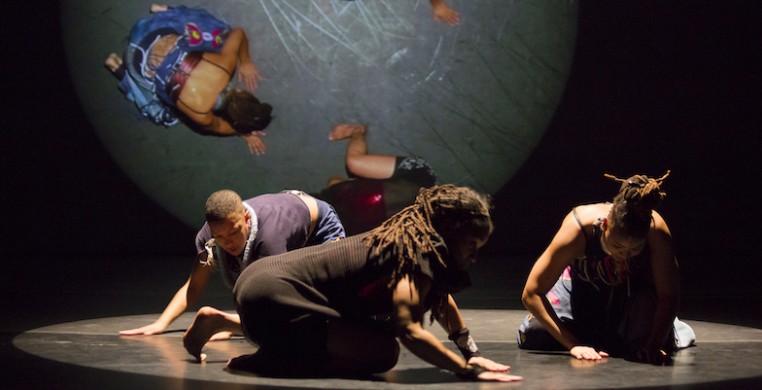“This is the urgent dialog of the 21st century,” says a bolded sentence in the program for the Chicago premiere of Urban Bush Women’s “Hair & Other Stories” at the Dance Center of Columbia College.
It’s not unusual to see UBW at the Dance Center. They were just here in 2016, and the year before that, too. And for more than 30 years, artistic director Jawole Willa Jo Zollar has created important, provocative work, often centered on social justice and African diasporic experiences.
Inevitably, like most companies who surpass three decades, I suspect Zollar is starting to wonder about a succession plan. She wasn’t there last night, for the Chicago premiere of “Hair & Other Stories,” leaving it to associate artistic directors Chanon Judson and Samantha Speis to lead the company (whose importance cannot be overstated) for this brief stop in Chicago.
Urban Bush Women’s “Hair & Other Stories” has one more performance tonight at the Dance Center.
Zollar and Elizabeth Herron conceived a work called “HairStories” in 2001. A play on words, “HairStories” chronicles the personal histories of black women through the lens of hair. The premise: hair (and white people’s fascination with it) creates a point of entry for a transparent dialog about race. In the 18 years since “HairStories” was made, there has not been enough progress in confronting racism in the United States, nor demystifying black hair and redefining beauty in an inclusive way. “Diversity,” “equity” and “inclusion” should be innate to our social construct – these, unfortunately, are just buzz words, a matter of political correctness.
So, it feels fitting and necessary for Judson and Spies to revisit this work, introducing new contextual references culled from their present-day experiences – only to find that not much has changed.
With the use of text, dance and vocals, the performers – among them is the most adorable toddler I’ve ever seen – reclaim the word “nappy,” and describe the various lengths black women have gone through to smooth and soften their hair, coiffing it into styles and looks still held by many as the standard of beauty. This often becomes funny, especially when the cast satirically stages a repeated elevator scene, mocking the discomfort and weird awkwardness white people have encountering black hair.
These vignettes are sprinkled throughout a two-and-a-half-hour evening, but “Hair & Other Stories” is mainly influenced by UBW’s work with the People’s Institute, an organization whose signature workshop series is called Undoing Racism. The audience is not simply permitted to sit back and relax; audience members are asked to stand up, identify who they are, and define what liberation could look like. This work is a call to action, an attempt to heal deep wounds that, in 2019, are bubbling painfully close to the surface. Depending on the histories of the people in the room (which in this case, by the way, was quite diverse), "Hair & Other Stories" could be affirming, uncomfortable, or somewhere in between. Arguably, self-selection bias – who chooses to buy tickets to a performance about race – means it’s more likely the former, with the people in the audience having already done some amount of work to address their biases and assumptions about race, and possessing an interest in dialoging with others about it.
I’m going to be honest: I didn’t like “Hair & Other Stories.” For me, Urban Bush Women failed to convert a workshop into a transformative artistic experience. This show is too long; it needs editing and dramaturgical guidance. Presentational elements are underutilized and passé. Expectations around audience participation are not managed with delicacy. More importantly, the cast makes assumptions about who’s in the room, presenting binary this-or-that options.
None of that means that I’m not glad I was there.
Can Undoing Racism workshops undo racism? Can a performance? I don’t know, but it’s worth it to try, which is why it doesn’t matter whether or not I liked or enjoyed this concert. It gave me something to think about, and I went home questioning my assumptions about art – and that’s how we begin to reconcile and heal, right?
What continues to draw me to dance is the opportunity it provides to use movement to question my view of the world, affirm it, or both. Two moments in this evening really, truly did that: The first was an extended trio in which three women scrub their skin, chanting "rinse, lather, repeat," as if trying to wash the color out of their own and each others' skin before descending to hands and knees to scrub at the marley floor. The second: each performer (sans toddler) stood onstage in two diagonal lines, contained in sharply cut boxes of light, shuddering. It looked to me like an embodiment of frustration, anger, catharsis and spirituality, all at the same time. Staccato breaths hovered just in front of their noses and mouths, growing in intensity until they were nearly screaming.
Then a blackout.

